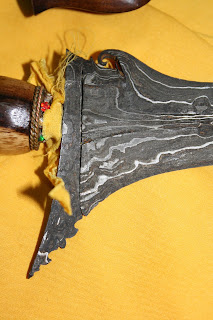Silat is a collective word for indigenous martial arts of the Malay Archipelago of Southeast Asia. Originally created and developed in Sumatera Island and Java in what is now Indonesia, then spread to peninsular Malaysia, southern Thailand and Singapore, silat was also traditionally practiced in Brunei, Cambodia, Myanmar, Vietnam and the Philippines. As a result, it is closely related to other Southeast Asian martial arts including krabi krabong and eskrima. Practitioners are called pesilat. The Chinese fusion of silat is known as kuntao
There are hundreds of different styles but they tend to focus either on strikes, joint manipulation, bladed weapons, throws, animal-based techniques, or some combination thereof. Silat schools are overseen by separate national organizations in each of the main countries the art is practiced. These are
Ikatan Pencak Silat Indonesia (IPSI) from
Indonesia,
Persekutuan Silat Kebangsaan Malaysia (PESAKA) from
Malaysia,
Persekutuan Silat Brunei Darussalam (PERSIB) from
Brunei and
Persekutuan Silat Singapura (PERSIS) from
SingaporeThe actual history of Silat is unknown. Folklore has it that Pencak Silat (the Silat style of today's Indonesia) was created by a woman named Rama Sukana who witnessed a fight between a tiger and a large bird. She then taught the techniques to her husband Rama Isruna from whom they were formally passed down. There are several variations of this story depending on the region where it is told. On the island of Bawean, Rama Sukana is believed to have watched monkeys fighting each other while the Sundanese people of West Java believe that she created cimande after seeing a monkey battle a tiger.
Meanwhile, Silat Melayu (the Silat style of current-day peninsular Malaysia) was believed to have been influenced by silambam, a martial art brought into the region by the Hindu-Buddhist kingdoms who have been in contact with the Malays even before the rise of Malacca Sultanate as evidenced by Kedah's 5th century Bujang Valley civilisation. Over time, Silat Melayu was refined into the specialized property of royalty, pendekar, and generals. Kings encouraged princes and children of dignitaries to learn silat and any other form of knowledge related to the necessities of combat. Prominent fighters were elevated to head war troops and received ranks or bestowals from the raja. One of these was the famous 15th-century Melakan warrior Hang Tuah.
Southeast Asia trade had already extended into Okinawa and Japan by the 1400s. The number of Japanese people travelling to Java and Malacca increased after the Battle Of Sekigahara. By the early 1600s there were small Japanese communities living and trading in Indochina. The Okinawan karate was believed to be influenced by Silat. Silat also share similarities in throws and stances of other weapon-based Japanese martial arts[3] which may date back to this time. Trade with Japan ended when the country went into self-imposed isolation but resumed during the Meiji era, during which time certain areas of Malaysia and Singapore became home to a small Japanese population. After the Japanese Occupation, some silat masters incorporated the katana into their styles. The weapon is still used in some systems today although its application has little relation to actual Japanese kenjutsu.
Silat warriors wore minimal armour, if any at all. A rattan shield or a breastplate, was the only protective gear used to Silat users. The older forms of silat consequently relied more on agility than they do today. During the colonial era when the western system of law enforcement was introduced, police officers who practiced silat emphasised trapping and joint locks so as to disable criminals without killing or injuring them unnecessarily. The styles created during this period are the most widespread today. Indonesians and Malaysians would later use silat to liberate themselves from the colonial Dutch and British, respectively[4], such as in the case of Tok Janggut.
Since the Islamisation movement of the 1980s and 90s, there have been attempts to make silat more compliant with Islamic principles. It is now illegal for Muslim practitioners in Malaysia to chant mantera, bow to idols or practice traditional meditation to supernatural powers. This has given rise to various misconceptions that silat is inherently Muslim or can only be practiced by followers of the Islamic faith. In actuality silat has existed long before Islam was introduced to Southeast Asia and is still practiced by non-Muslims. The Hindu-Buddhist and animistic roots of the art were never eradicated, and remain very evident even among Muslim practitioners of traditional styles. Balinese exponents often argue that the newer and more "Islamised" forms are less authentic and less useful in real combat. Some of these old methods have been lost after silat masters in pre-dominantly Muslim areas could no longer teach them, but others still endure among conservative training schools in Indonesia and Thailand.
catatan dari: wikipedia










